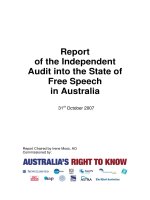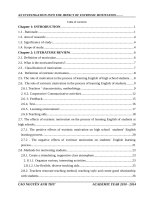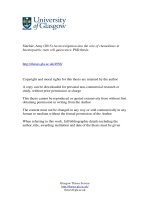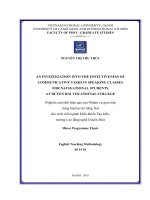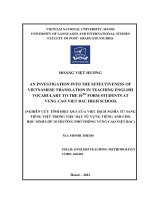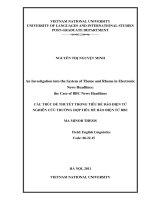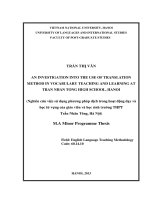An investiagtion into the state of plagiarism in writing assignments among third year students majored in English in one of Vietnamese University and some preventive teaching strategies
Bạn đang xem bản rút gọn của tài liệu. Xem và tải ngay bản đầy đủ của tài liệu tại đây (1.19 MB, 66 trang )
VIETNAM NATIONAL UNIVERSITY, HANOI
UNIVERSITY OF LANGUAGES AND INTERNATIONAL STUDIES
FACULTY OF POST-GRADUATE STUDIES
--------
HOÀNG THỊ HỒNG
AN INVESTIGATION INTO THE STATE OF PLAGIARISM IN
WRITING ASSIGNMENTS AMONG THIRD-YEAR STUDENTS
MAJORED IN ENGLISH IN ONE OF VIETNAMESE UNIVERSITIES
AND SOME PREVENTIVE TEACHING STRATERGIES
(ĐIỀU TRA VỀ TÌNH TRẠNG ĐẠO VĂN TRONG VIẾT TIỂU LUẬN
CỦA SINH VIÊN CHUYÊN NGÀNH TIẾNG ANH TẠI MỘT TRƯỜNG
ĐẠI HỌC CỦA VIỆT NAM VÀ GỢI Ý MỘT SỐ CHIẾN LƯỢC
GIẢNG DẠY)
M.A. MINOR PROGRAMME THESIS
Field: English Teaching Methodology
Code: 60140111
Hanoi, 2014
VIETNAM NATIONAL UNIVERSITY, HANOI
UNIVERSITY OF LANGUAGES AND INTERNATIONAL STUDIES
FACULTY OF POST-GRADUATE STUDIES
--------
HOÀNG THỊ HỒNG
AN INVESTIGATION INTO THE STATE OF PLAGIARISM IN
WRITING ASSIGNMENTS AMONG THIRD-YEAR STUDENTS
MAJORED IN ENGLISH IN ONE OF VIETNAMESE UNIVERSITIES
AND SOME PREVENTIVE TEACHING STRATERGIES
(ĐIỀU TRA VỀ TÌNH TRẠNG ĐẠO VĂN TRONG VIẾT TIỂU LUẬN
CỦA SINH VIÊN CHUYÊN NGÀNH TIẾNG ANH TẠI MỘT TRƯỜNG
ĐẠI HỌC CỦA VIỆT NAM VÀ GỢI Ý MỘT SỐ CHIẾN LƯỢC
GIẢNG DẠY)
M.A. MINOR PROGRAMME THESIS
Field: English Teaching Methodology
Code: 60140111
Supervisor: Dr. Phạm Thị Thanh Thuỳ
Hanoi, 2014
DECLARATION
I, hereby, certify the thesis entitled “An investigation into the state of plagiarism in
writing assignments among third-year students majored in English in one of
Vietnamese Universities and some preventive teaching strategies” is the result of
my own research for the Minor Degree of Master of Arts at the University of
Language and International Studies, Vietnam National University, Hanoi, and this
thesis has not, wholly or partially, been submitted for any degree at any other
universities or institutions.
Hanoi, 2014
HOANG THI HONG
i
ACKNOWLEDGEMENTS
I would like to acknowledge my deep gratitude to all those who have
supported me in doing this independent study.
Firstly, I would like to express my greatest appreciation to my supervisor,
Dr. Pham Thi Thanh Thuy, for her valuable time and useful guidance towards the
completion of this study.
Secondly, I am extremely grateful to the staff members of the Faculty of Post
- graduate studies for their helpful lectures.
My special thanks are also sent to my lecturers, my friends, my classmates,
as well as my colleagues for their invaluable comments and criticism and also for
their continued interest and encouragements.
Thirdly, I appreciate the assistance and cooperation given to me by lecturers and
students at National Economics University. Without their sincere participation, this
paper would not have been possible.
Last but not least, I want to express my deepest gratitude to my beloved
people, my parents, my husband and my children for their love, care, tolerance and
encouragement.
ii
ABSTRACT
This article explores the issue of plagiarism from the perspective of students
studying in Vietnamese Universities. The study was designed to investigate
students’ awareness regarding plagiarism. The writer also attempted to measure the
state of plagiarism among university students in terms of the forms and the
seriousness of plagiarism. She then wanted to identify some preventive teaching
strategies to improve academic practice (including academic writing and
referencing skills) based on the results gained. To some extents, findings from the
study indicate that the students had inadequate understanding about plagiarism
definition and its notion, plagiarism policies, and penalty for acts of plagiarism.
Therefore, they had committed most of common forms of plagiarism: using
paraphrased, summarized, quoted texts without showing the original sources,
inventing biblography or data, and submitting online papers and handing as their
owns. Level of seriosness of plagiarism acts was varying from copying some key
words, sentences to entire of their assignments. The most serious case was that
some students submitted an online work and handed in as their own. The number of
this case is not high; still it is also an alarm to educators. However, most of students
were unintentional plagiarists due to objective causes like their unawareness of
plagiarism, lack of proof reading, poor writing academic skills and carelessness
when taking an assignment. Some others committed plagiarism intentionally
because of some subjective causes like their laziness, bad time management, desire
of higher grades, pressure from family and friends. Nevertheless, the problem of
plagiarism should not fall on the shoulders of the students alone. The instructor
should take responsibility for neither checking for plagiarism nor teaching about
ethics, which is one course rarely offered in universities. The solution would be
resolved from the top, teachers should be a good model of plagiarism fighters. In
this minor thesis, the researcher would like to offer some preventive teaching
strategies against plagiarism.
iii
LIST OF ABBREVIATIONS
EFL: English as Foreign Language
FLF: Foreign Language Faculty
NEU: National Economics University
Ss: Students
Ts: Teachers
iv
LIST OF FIGURES
Number
Name
Page
1.
Figure 1: Frequency of having students do writing
19
assignment
2.
Figure 2: Difficulties students encounter when they write an
20
assignment
3.
Figure 3: Students’ awareness of plagiarism policy
21
4.
Figure 4: Students’ awareness of plagiarism penalty
22
5.
Figure 5: Teachers and students’ attitude towards plagiarism
23
at the university
6.
Figure 6: Teachers’ and students’ experience of plagiarism
24
incidences
7.
Figure 7: Common forms of plagiarism that students often
25
commit
8.
Figure 8: Seriousness of student plagiarism at the university
29
9.
Figure 9: Reasons of student plagiarism
30
10.
Figure 10: What the students should do to avoid plagiarism
31
11.
Figure 11: What the teachers should do to reduce plagiarism
32
12.
Figure 12: What the university should do to limit plagiarism
33
v
TABLE OF CONTENT
DECLARATION ................................................................................................... I
ACKNOWLEDGEMENTS ................................................................................. II
ABSTRACT ........................................................................................................ III
LIST OF ABBREVIATIONS .............................................................................IV
LIST OF FIGURES .............................................................................................. V
TABLE OF CONTENT ......................................................................................VI
PART A: INTRODUCTION ................................................................................ 1
1. Rationale.......................................................................................................... 1
2. Purpose of the study: ...................................................................................... 2
3. Research questions .......................................................................................... 3
4. Scope of the study ........................................................................................... 3
5. Significance of the study: ................................................................................ 3
6. Design of the study .......................................................................................... 4
PART B: DEVELOPMENT ................................................................................. 5
CHAPTER 1: THEORETICAL BACKGROUND .............................................. 5
1.1 Theoretical background.................................................................................. 5
1.1.1
What is plagiarism? .............................................................................. 5
1.1.2
Text plagiarism...................................................................................... 6
1.1.3
Forms of plagiarism .............................................................................. 8
1.1.4
Why students tend to plagiarize? ......................................................... 9
1.1.5
Penalty for student plagiarism ........................................................... 10
1.2 Review previous studies ................................................................................ 11
CHAPTER 2: RESEARCH METHODOLOGY ............................................... 14
2.1 Research questions: ...................................................................................... 14
2.2 Research methodology .................................................................................. 14
2.2.1
Questionnaires ..................................................................................... 15
2.2.2
Discourse analysis: analysis of students’ essays ................................. 16
2.3 Data collection procedure ............................................................................. 16
vi
2.3.1
The setting of the study ....................................................................... 16
2.3.2
Participants’ background information .............................................. 17
2.3.3
Procedure ............................................................................................ 17
2.4 Data analytical units ..................................................................................... 18
CHAPTER 3: DATA ANALYSIS AND DISCUSSIONS .................................. 19
3.1 The difficulties students encounter when taking a writing assignment ...... 19
3.1.1
Difficulties in doing a writing assignment ........................................... 19
3.1.2
Students’ awareness of plagiarism ....................................................... 21
3.1.3
Forms of plagiarism committed by students ...................................... 24
3.1.4
Seriousness of student plagiarism ...................................................... 28
3.1.5
Reasons for student plagiarism .......................................................... 29
3.1.6
Ways to reduce student plagiarism .................................................... 30
3.2 Summary ....................................................................................................... 33
CHAPTER 4: FINDINGS AND RECOMMENDATIONS ............................... 35
4.1 Students’ awareness of the notion of plagiarism and its penalty ................ 35
4.2 Main forms of plagiarism caused by students ............................................. 35
4.3 Reasons for student plagiarism .................................................................... 36
4.5 Recommendations ......................................................................................... 37
4.6.1
To students .......................................................................................... 37
4.6.2
To the teachers .................................................................................... 38
4.6.3
To university policy maker ................................................................. 41
PART C: CONCLUSION ................................................................................... 43
1. Recapitulation .................................................................................................. 43
2. Pedagogical implication ................................................................................... 44
3. Limitations ....................................................................................................... 45
4. Suggestions for further research ..................................................................... 45
REFERENCES .................................................................................................... 46
APPENDICES ....................................................................................................... I
APPENDIX 1a: SURVEY ON PLAGIARISM IN WRITING ............................ I
vii
APPENDIX 1b: SURVEY ON PLAGIARISM IN WRITING..........................IV
APPENDIX 2 – LIST OF TABLES .................................................................. VII
viii
PART A: INTRODUCTION
1. Rationale
“It’s just so easy. You see something interesting on the Web; you drag your mouse
over it, click on ‘copy’, open your word processor, and paste it in. A matter of
moments. Why not just incorporate it into what you are writing? Who is to know?”
(Eastment, 2005: 183)
Such of act is considered as plagiarizing. Plagiarism is regarded as a serious and
growing problem which significantly diminishes the academic integrity of
university education. In today’s digital age with breathtaking advancements in the
electronic storage, search and dissemination of information, plagiarism is rapidly
becoming a crisis. The jaw-dropping amount of documents available on the Internet
makes plagiarism so easy that students find it difficult to resist the temptation. They
tend to work late at night, do some “copy-and-paste” on a paper due the next
morning. Unfortunately, even when this apparent student ‘cut-and-paste’ mindset is
acknowledged, the extent of plagiarism and academic misconduct is likely much
worse than it appears. Recently, numerous studies have shown that plagiarism and
other types of academic fraud are increasing among undergraduate students. In a
study conducted in 2001, McCabe posits, based on students’ self-reported attitudes
that high school students may not consider cutting-and-pasting from the Internet to
be cheating. With the same result, Kraus (2002:84) expands this notion by being
“convinced that a rapidly growing number [of students] simply do not see
plagiarism as wrong.’ It is students’ unawareness that leads to the number of
plagiarists in universities is growing dramatically. In a recent article published by
the Center for Academic Integrity (CAI), Professor Don McCabe claims that “On
most campuses, 70% of students admit to some cheating” while “Internet plagiarism
is a growing concern” because although only “10% of students admitted to engage
in such behavior in 1999”, almost “40% admitted to it in 2005” (Mc Cabe, 2005).
In Vietnam, the number of plagiarist coming to light has increased dramatically
recently. In a recent study, QT789 Groups (2013) state that 58% students consider
1
plagiarism as normal, up to 75% students has plagiarized at least once at university.
Plagiarism among Vietnamese students is so popular that a foreign scholar has
claimed “[students in] Vietnam has a cheating cultural” (cited in Ngo Tu Lap,
2013). In the talk show ‘copy-paste’ (SIB, 2014), Hoang Minh Luong shares the
fact that in Vietnam, it is not surprising to find numerous assignments or even
graduated papers ready to be used in photocopy shops. Students just buy some and
make some changes and hand in as their own. For him “plagiarism is the intellectual
corruption or intellectual thief.”
Being a high school teacher, the author hardly has any chance to access the
academic settings to give a large point of view on plagiarism in professional
writing. Due to her desire of investigating the real situation in higher educational
environment, she managed to carry the minor research, entitled “An investigation
into the state of plagiarism in writing assignments among third-year students
majored in English in one of Vietnamese Universities and some preventive
teaching strategies”. In the light of this significant students’ viewpoint, and the
acknowledgement of how serious a problem academic plagiarism is, the writer
mentions to do a scrutinizing research on state of plagiarism as well as students and
teachers’ awareness of plagiarism with the hope of providing additional insight.
2. Purpose of the study:
The study aims at providing additional insight about plagiarism among students
NEU. By doing so, the writer attempts to suggest some of preventative teaching
strategies in order to limit this academic misconduct. In order to achieve this aim,
the study has to fulfill the following objectives:
- obtaining students’ awareness at one of Vietnamese Universities regarding
plagiarism.
- investigating the state of plagiarism at university in terms of forms and
seriousness
- identifying some preventative teaching strategies for raising awareness of
students and improving academic practice
2
3. Research questions
In order to find out whether the students have a fulfill understanding about
plagiarism, especially in academic writing, and the state of plagiarism among
Vietnamese students. This study was designed to highlight the following research
questions:
- What is students’ awareness of plagiarism at the university?
- What are some common forms of plagiarism committed by university students?
- What are some ways to raise awareness of plagiarism among students?
- What are some preventative teaching strategies in order to reduce plagiarism
among students?
4. Scope of the study
Due to the limit of time and restricted scope of study of a minor thesis, the study
only focused on measuring students’ awareness regarding plagiarism at the
university, the common forms of plagiarism committed by students as well as the
factors underlying student plagiarism at the target university. Based on that, some
recommendations on preventative teaching strategies are given for teachers to raise
students’ awareness and to limit act of plagiarism among students.
The study was limited to the area of teaching and learning academic writing skills
among 60 third –year students majored in English and 12 teachers in FLF of NEU
5. Significance of the study:
As one of the uninvestigated issues in teaching to write academically for university
students in Vietnam, the present study on students’ plagiarism in writing
assignments will make certain contributions to the development of Vietnamese
academic settings. The study is at the same time hoped to benefit teachers,
educationists and researchers of related fields.
• For students, the results of the study will give impact to the improvement of
their academic writing skills. Student knows how to make full use of critical reading
and reference citation skills to avoid plagiarism.
3
• For teachers, the findings of this study will give valuable and useful information
on teaching academic writing. Some suggestions on preventive teaching strategies
may help students overcome this serious academic dishonesty.
• The educationists may base on the facts provided in the study to make necessary
changes in terms of curriculum, facilities to limit academic misconduct and to
improve Vietnamese academic environment.
• The research will serve as the foundation for further related researches. Other
researchers may also take the strengths and weaknesses of the study into account to
better theirs.
6.
Design of the study
This minor thesis consists of three parts: the introduction, the development and the
conclusion.
Part A: Introduction. This part presents the rationale, the aim and objectives of the
study, scope of the study, method of the study and design of the study.
Part B: Development. It is divided into 4 chapters:
Chapter 1: Theoretical background. This chapter discusses the theoretical
background and previous studies relevant to the study.
Chapter 2: Research methodology. It discusses the research questions, the approach
adopted, the methods of collecting data, the data collection procedure (timeline),
and data analysis methods.
Chapter 3: Data analysis and discussion. It shows the detailed results of the surveys
and covers a comprehensive analysis on the data collected from questionnaires and
discourse analysis.
Chapter 4: Findings and recommendations. This part shows the findings and
suggests some preventive teaching strategies.
Part C: Conclusion. This part includes an overview of the study, suggestions for
further research and limitations of the study.
4
PART B: DEVELOPMENT
CHAPTER 1: THEORETICAL BACKGROUND
1.1 Theoretical background
1.1.1 What is plagiarism?
“Plagiarism” is a controversial concept among educators and scholars over the
world. It is rather difficult to define exactly what it is. In this part, the writer
attempts to make it clear by representing some previous studies.
Derived from the Latin word “plagiarius” (“kidnapper”), plagiarism refers to a form
of cheating that has been defined as “the false assumption of authorship: the
wrongful act of taking the product of another person’s mind, and presenting it as
one’s own” (Lindey, 1952 cited in Gibaldi, 2003:66). For this definition, plagiarist
commits two faults: intellectual theft and fraud since using and passing off other’s
ideas, information, or expressions on purpose but failing acknowledge the sources.
Plagiarism then is morally and ethically wrong, or is regarded exactly as literary
stealing. Sharing the same viewpoint, Ragen (1987 cited in Pecorari, 2008:27) with
his words: “to take a piece of writing without acknowledging the creator is plain
theft” was the verdict of an academic commenting on a case of plagiarism that
attracted public attention. Since then, the immorality of it has been proclaimed
frequently, and in scathing terms.
Although many researchers are concerned about the themes of plagiarism in their
studies, the phenomenon of plagiarism among students is still increasing. To
minimize it, many universities have put explicit penalties against this misconduct
behavior. However, they may not be aware that most students commit plagiarism
because of their misunderstanding this concept. Therefore, developing a clear
definition and showing students clearly what are allowed, what are not allowed to
do will provide big help in fighting plagiarism. Indiana University Bloomington
(2005) has documented the term plagiarism clearly as using other’s ideas and words
without clearly acknowledging the source of that information or just simple like
“taking credit for work that is not really theirs[writers] (Wilhoit, 2009:225).
5
Learning Support Network Curtin University of Technology (2005:4) states that
“plagiarism means presenting the work or property of another personas one’s own,
without appropriate acknowledgement or referencing.”
To sum up, plagiarism is a hard defined concept. However, Harris (2001: 133) may
offer the most easily understandable definition of plagiarism when he states that:
“Plagiarism is the failure to cite sources properly. Plagiarism is pretending that
an idea is yours when in fact you found it in a source. You can therefore be
guilty of plagiarism even you thoroughly rewrite the source’s words. One of the
goals of education is to help you work with and credit the ideas of others. When
you use another’s idea, and whether from a book, a lecture, a web page, a
friend’s paper, or any other sources, and whether you quote the words or restate
the idea in your own words, you must give that person credit with a citation. No
source may elect not to be cited”.
Plagiarism is sometimes a moral and ethical offense rather than a legal one since
some instances of plagiarism fall outside the scope of copyright infringement, a
legal offense (Gibaldi, 2003: 66).
1.1.2 Text plagiarism
The term text [textual] plagiarism, for Pecorari (2008: 4), actually refers to the act
of reusing “words and/or ideas from another source, without appropriate
attribution”. He also classifies this term into two categories: prototypical plagiarism
and patch-writing (distinguished by the presence or absence of intentional
deception). For him, “prototypical plagiarism” is defined as the use of words and/or
ideas from another source, without appropriate attribution, and with the intention to
deceive (p4). “Patch-writing”, on the other hand, is characterized by the lack of
deceptive intent. Rebecca Howard (1999, cited in Pecorari, 2008:5) defines this
term as ‘copying from a source text and then deleting some words, altering
grammatical structures, or plugging in one synonym for another’. In this way,
patch-writing is virtually inevitable as writers learn to produce texts within a new
discourse community, and is a beneficial part of the learning process, a primary
means of understanding difficult texts, of expanding one’s lexical, stylistic, and
conceptual repertoires, of finding and trying out new voices in which to speak.
6
Patch-writing gives writers the chance to flex their muscles under controlled and
guided circumstances—guided by the linguistic choices of the source authors.
Patch-writing comes about as a result of novice writers’ need for support as they
develop, and not because the writer intends to deceive the reader. Patch-writing
and prototypical plagiarism can therefore be seen as subcategories of textual
plagiarism, distinguished by the presence or absence of intention to deceive (Figure
1.1).
Figure 1.1 Types of plagiarism (Pecorari, 2008: 5)
To make it clear, some scholars define textual plagiarism into two types:
unintentional plagiarism and intentional plagiarism in term of with and without
intention of plagiarizing.
1.1.2.1 Unintentional plagiarism
Unintentional plagiarism occurs when students use the words or ideas of others but
fail to quote or give credit, usually because they do not know how. Examples of
unintentional plagiarism include omitting a citation or citing inaccurately,
paraphrasing by only changing the sentence structure of the original text or by
changing the sentence structure but not the words, and putting quotation marks
around only a part of a quotation (Pecorari 2003: 318). It sometimes is the result of
the writer’s inability to decide or remember where the idea came from. He may
have read it long ago, heard it in a lecture since forgotten or acquired it secondhand
or third-hand with colleagues.
1.1.2.2 Intentional plagiarism
The most serious case of academic thievery is plagiarizing intentionally. It happens
when writer or researcher intends to copy the thoughts or language of others and
claims them for his own. Student commits plagiarism intentionally when he asks the
7
essay of another student and copies out parts of it or downloads sections of Internet
sources with no references for the reader. These are clearly deliberate actions by the
student, and often are designed to deceive the teacher, although occasionally there
are situations where student may be unaware that these actions are not sanctioned
(Wendy, 2008: 30-31)
1.1.3 Forms of plagiarism
According to Gibaldi (2003:70-71), the most conspicuous form of plagiarism is to
obtain and submit as your own a paper written by someone else. Other forms of
plagiarism occur when the writer fails to acknowledge the sources, including of
repeating and paraphrasing another’s wording, taking particularly apt phrase, and
paraphrasing another’s argument or presenting another’s line of thinking.
Wilhoit (2009: 225-228) makes it clear by identifying seven forms of plagiarism
that covers both the presence and absence of intention to deceive as followed:
- Purchasing a paper: buying a paper from other and turning it in as if it were
one’s own
- Turning in a paper someone else has written for you: letting one take credit for
work the other has actually completed
- Turning in another student’s work without that student’s knowledge: searching
another student’s file or paper on computer and turning it in as if it were your own
- Copying a paper from a source text without proper acknowledgement: copying
directly the whole or part of an essay from electronic materials without proper
quotation and documentation
- Copying material from a source text, supplying proper documentation, but
leaving out the quotation marks
- Paraphrasing material from a reading without proper documentation: using
your own words to paraphrase the source text without documenting the passage
properly is a kind of stealing the other’s ideas
In conclusion, acts of plagiarism may vary from the most blatant (intentional
copying of a whole paper and pretending that one has originally produced it) to
unintentional (or getting to place quotation marks around a quote) or even
unconscious (unconsciously repeating a memorable line from one’s reading).
Deliberate plagiarism is a matter of dishonesty while unintentional plagiarism is
8
usually a matter of laziness or carelessness. However, even if a writer has made an
honest mistake, it appears equally grievous to the readers.
1.1.4 Why students tend to plagiarize?
Plagiarism is prevalent among students in academic integrity. Numerous studies
have shown that many factors have been proposed for why students cheat or
plagiarize. To make it clear, the factors causing plagiarism among students can be
clarified into five following categories (Sentleng, 2010: 58-59):
School instruction: the roots of plagiarism can be traced to high school
instruction as learners have earned good grades (Walker 1998: 93).
Subjective and objective factors: Subjective causes include attitudinal and
individual circumstances, ambition and competitive energies of participants of
academic life and ignoring the rules and conventions that represent what is right and
what is acceptable. Objective causes; however, include pressures and expectation
directed at individuals by society, family and other external sources. It also includes
society’s demands for skilled and educated workers and professionals. For these,
lack of adequate subject knowledge can force students to rewrite exactly from
sources.
Referencing skills: Lloyd (2007: 52) stated that many students do not posses
academic writing skills. Students need to be constantly reminded why referencing is
important. Referencing methods, referencing techniques and acknowledging all
forms of intellectual material must be taught.
Assignments: Wendy (2008: 5) suggested that plagiarism can be reduced if a
lecturer puts effort into setting the assignments. Topics must, for example, not be too
generic. The same topics must not be given every year and assignments with similar
topics must not be easily found on the internet.
Use of the internet: As the internet is a public domain, students perceive
information on the internet as free to use. The internet has made plagiarism easier.
You can cut and paste information directly into word processed documents,
because complete essays, assignments and articles can be downloaded either for free
or for a fee (Lathrop & Foss 2000: 22-24).
In conclusion, there are many factors that cause student plagiarism. However the
most important thing is that students sometimes have no sense of what they are
allowed or not allowed to do. They are not well-prepared about academic writing
skills or time management skills. They may feel that they have too many
assignments to do and if these assignments are poorly designed, students tend to
plagiarize when the time is at due. Moreover, education upbringing also plays a key
9
role. In some countries, especially Asian countries, rote-learning are encouraged.
Students are expected to learn by heart the knowledge from text books. The more
accurately a student can recall information, the better (s)he is assessed to be. It is
this attitude that leads to students’ restricted consciousness of plagiarism.
1.1.5 Penalty for student plagiarism
Punishments for students who plagiarize range from failing grades on individual
assignments to flunking an entire course - or worse. Some schools have revoked
degrees from people whose plagiarism came to light months or years after they
graduated. At other schools – especially those with strict honor codes – plagiarism
can be grounds for suspension or expulsion.
Penalty for act of plagiarism also varies among univeristies or countries. Monash
Univeristy in Australia states that punishments will depend on whether students
plagiarize intentionally or unintentionally. For them intentional plagiarism is
defined as cheating and unintentional plagiarism is defined as “academic
misdemeanor.” So if a student unintends to plagiarize, a warning will be given
(Monash University, 2007 cited in Wendy, 2008: 65).
Birmingham University, on the other hand, gives very detailed information about
how cases of plagiarism are both decided and also penalized. The policy of the
school assists teachers to decide how serious the case of plagiarism is by
quantifying the amount of plagiarism in the student’s work: “serious” is calculated
as 10 percent of the complete work; “moderate” is calculated between 5 and 10
percent and “slight” is where less than 5 percent of the total work has been
plagiarized. Once that calculation is complete, the penalty for the offense will
automatically follow the formula (Wendy, 2008: 65-66).
In Vietnam, Laws on Intellectual Property have been applied to protect authorships
and copyrights. According to this law, penalties for acts of plagiarism depend on the
level of seriousness. Plagiarists can get the caution, monetary fine or even be
criminally handed.
10
In universities or colleges, for small assignments, plagiarists will be graded zero for
proportions that plagiarism occurs. If repeated, students will be suspended or
expelled from school. For graduated papers, M.A thesis or other scientific papers, if
plagiarism happens, these papers will not be approved.
More seriously is the case of Hoang Xuan Que, a lecturer in a famous university
(National Economics University). In his Doctoral thesis, he had used 30.2% thesis
paper of Dr. Mai Xuan Que (52.9/159 pages) without indicating the original author
in his references. Some of his paragraphs repeated exactly the source text, leaving
the quotation marks. When his case came out the light, Vietnamese Ministry of
Education and training had revoked his degree after ten years of his graduation.
To sum up, most universities and colleges have a range of penalties from warnings,
reprimands, failure of the piece of assessment under review, failure of the unit or
subject in which the plagiarism occurred, suspension from study for a period of
time, monetary fine or expulsion from the university. No matter what plagiarism
each university defines as, it is cclearly that this unethical behaviour needs to be
stamped out to build a healthy academic environment.
1.2 Review previous studies
Recently, there have been numerous studies carried out in order to investigate the
incidences of plagiarism among college students. These studies also indicated the
continuous growth in student plagiarism. Most of the studies agree that students are
well-aware of plagiarism as an unaccepted practice or a wrongful act in academic
writing. In his servey, David R. Neumann (2002) indicated that nearly 90 percent of
students strongly view major acts of plagiarism as unethical. In Far East educational
settings the concept of plagiarism is also related to an immoral practice or act of rob
or steal someone’s writing.
However, recent studies also claim that this misconduct behaviour is becoming a
serious problem among universities and that students plagiarized their work in a
substantial amount. McCabe (2005), in a study of 50,000 undergraduate
students on more than 60 US campuses, found that 70 percent admitted to
11
cheating in some form. Other recent studies have noted the incidence of cheating
at university ranging from 50 percent of students to around 75 percent (Park 2003).
This continuing of student plagiarism is blamed for some factors both subjective
and objective causes. Some western reseachers have implied Asians students tend to
plagiarize more often than their western counterparts. Besides, cultural factors, for
them, play as the key role in contributing plagiarism in these Asian countries. To
support, Yamada (2003: 252) emphasizes differences in cultural perceptions of the
importance of acknowledging sources of information when taking a written
assignment as the root causing international student to involve into plagiarism.
However, Ha (2006: 77), Thao Doan (2012: 30) and Liu (2005: 235) fought against
this viewpoint by saying that “Western academics may rush to accuse overseas
students”. They then gave some examples to illustrate their arguments that copying
from other’s work is punished heavily in their countries. However, they also state
that it is different in educational upbringing that causes the significant rates of
accidential plagiarists in those countries. It is not surprising to catch Vietnamese
students making mistakes in referencing when taking a written assignment in
western academic settings. Because in Vietnam, students just acknowledge the the
research by adding the name of the author, not providing the year of publication and
the publishers. Furthermore, in Vietnamese education, students are not taught
critical thinking, and how to acknowledge others’ ideas; therefore, they often copy
others’ ideas without knowing that is plagiarism. Besides, Vietnamese students do
not aware the danger of plagiarism.
So, how can we solve this problem? To address this Dujsik (2002: 24)
recommended four practical approaches which include setting up a serious penalty
so that students will have to follow the right procedure and obey the rules, raising
students’ awareness of plagiarism by discussing the issue in details, monitoring
students’ writing process by assigning them to do the writing task at various steps,
and equipping students with citation skills by teaching them to quote, paraphrase
and summarize. Sherman (1991: 194 – 195), on the other hand, offers a very
12
interesting method – a cultural syllabus, in which “students will not have to
eradicate their own habits of thought and expression, but will be adding new
patterns to their intellectual repertoire and producing the kind of speech appropriate
to the immediate environment.”
To sum up, the issue of plagiarism is interestingly discussed many studies and
among researchers around the world. Students plagiarize in different ways varying
from unintentional type such as giving verbatim answer, rote-learning for exams,
borrowing others’ words and ideas without acknowledging the source, to
intentionally stealing others’ papers and treat them as their own. The causes for this
phenomenon also vary from country to country. Asian students plagiarize because
they lack awareness of the notion of plagiarism, citation skills and teacher
monitoring during the writing process, whereas Italian students (Sherman, 1991:
192 – 193) do so because they fail to distinguish fact from opinion, to develop
argument or just because they want to maintain their “bella figura”.
However, the problem of plagiarism, to some extent, is grey theory in Vietnam.
There are not many researches or studies taken to explore this misconduct
academic. Some studies just focused on the students’ awareness, perception or
attitude towards plagiarism or the results contributing this phenomenon. What’s
more, most of these studies are carried out among oversea Vietnamese Students
where students are more or less affected by Western culture in writing academic. So
these theories or results are quite general and difficult to adapt effectively in
Vietnamese university settings. Attempting to paint a small picture related to this
phenomenon in Vietnam, I would like to carry the minor study, namely “An
investigation into the state of plagiarism in writing assignments among third-year
students majored in English in one of Vietnamese Universities and some preventive
teaching strategies”, hoping that it can contribute some useful information for EFL
teachers in general, and my teaching profession in particular.
13
CHAPTER 2: RESEARCH METHODOLOGY
This chapter discusses the methodology used to investigate the state off
plagiarism among students. There are four main parts in this chapter: the research
questions, the approach adopted the methods of collecting data, the data collection
procedure (timeline), and data analysis methods.
2.1 Research questions:
The present study attempts to investigate the awareness of students and teachers of
plagiarism, the state of plagiarism among students majoring in English. In the light
of literature, this study aimed to highlight the following research questions:
1. What is students’ awareness of plagiarism at the university?
2. What are some common forms of plagiarism committed by university students?
3. What are some ways to raise awareness of plagiarism among students?
4. What are some preventative teaching strategies in order to reduce plagiarism
among students?
2.2 Research methodology
Qualitative & quantitative methods are both used to find answers to the research
questions above. According to Morse, Janice. M (2003: 189), “Using more than one
research within a research program, we are able to obtain a more complete picture
of human behavior and experience. Thus we are better able to … achieve our
research goals more quickly.” Such a mixed method provides a detailed and
comprehensive picture about what is being investigated. Qualitative and
quantitative data will be collected with discourse analysis and questionnaires
correspondingly.
Survey questionnaires and discourse analysis are the two main instruments to
collect the data. The data from the discourse analysis are of great assistance to
ensure the validity of the information gathered from the survey questionnaire. The
discourse analysis was done through analyzing students’ essays. The criteria
judging the seriousness of plagiarism was bases on the policies towards plagiarism
of Birmingham University cited in Wendy’s (2008: 64-65). Thanks to these, the
14
result is more reliable and helps the researcher investigate the state of student
plagiarism clearly and suggest some preventative teaching methods more easily.
2.2.1 Questionnaires
Questionnaires are considered to be useful for exploration and confirmation. One of
the strengths of questionnaires is measuring attitudes and eliciting participants’
ways of thinking. “Questionnaire was opted with consideration for its apparent
multi-advantage and particular suitability for quantitative research” (Dörnyei,
2003). In this study, questionnaires were designed to investigate students’
awareness of plagiarism and factors hind students’ misbehavior.
2.2.1.1The questionnaire for the students
All questions were written in English. The questionnaires were also piloted with the
help of five students before delivering to the large number. The questionnaires are
included 12 closed questions. At the end of the questionnaire, students have a
chance to mention their own ideas and viewpoints on plagiarism through an open
question. These are focused on discovering factors that hinder students’
performance in their writing assignments (question no. 1, 2), their awareness of
plagiarism (question no. 3, 4, 5), the main forms of plagiarism committed by
students (question no. 7), level of seriousness of student plagiarism (question no. 8),
the reasons for their plagiarism (question no. 9,), their comments on ways to limit
plagiarism among students (question no. 10, 11, 12)
2.2.1.2The questionnaire for the teachers
With the help of three teachers for doing piloted questionnaire, the researcher could
fully complete the questions. The questionnaire for teachers is written in English.
There are 12 closed questions in this questionnaire. The last question is an open
question. Teachers can share their different ideas and views on plagiarism. In
general, all questions are aimed at finding out the teachers’ comments on students’
difficulties in writing assignments (question no. 1, 2), students’ awareness of
plagiarism (question no. 3, 4, 5, 6), the main forms of plagiarism committed by
students (question no. 7), level of seriousness of student plagiarism (question no. 8),
15

